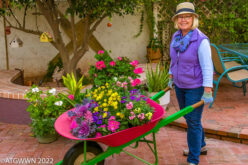
I became impatient listening to the tour guide explain 700 years of history. Already I calmly sat through a long bus ride from the port of Cadiz to Seville to get to the Royal Palace Gardens of Alcazar. I wanted only to see the garden. So. . . . I slipped away from our tour group.

I found a courtyard with clipped myrtle hedges, framed by tiled archways, a terra cotta fountain splashing into a fish pond.

Another court yard had tiled benches and a stairway lined with pots of rosemary leading up to a second level. The passage-way covered with vine created a shady walk and following this I quickly returned to the entry hall, rejoining the group.

The tour guide was explaining the patterns of the tile work, illustrating its lack of symmetry due to the Islamic belief that perfection in symmetry challenged the perfection of god. I could not stay and listen.
Alcazar illustrates significant history in garden design. It began in the 12th century when Arab princes conquered Spain. Alcazar began as a Paradise garden for themselves and an ostentatious symbol of power. In this climate controlling the water supply was the most powerful control of life.





I found the exit, but no sign of the group. I walked out on the street. No one familiar could be seen. I walked back in but was stopped by a guard telling me I could not re-enter. I explained I was separated from my group. He shrugged and let me pass.
I went into the gift shop. There are almost always stragglers from a tour hurrying with last minute shopping and there were. Not a single shopper from my group was there.

I began to worry, I went back into the garden, to the main pool. I turned back toward the the dark passage way leading to the exit. Surrounded by people I heard Rich call my name. He too, had lagged behind in the garden and when he caught up to the group and discovered I wasn’t there he came back to find me. Now to find our way back to the bus alone through a maze of streets, groups of other tours, and local shoppers in the Old Jewish quarter of Seville. We came into a small unfamiliar square which had three exits. I knew the pickup point was at the bottom of the Murillo gardens, I asked a young man for directions, he pointed the way and we ran to catch our bus.
